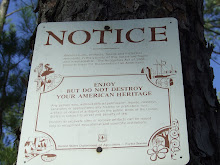
Monday, September 17, 2012
Lookout Tower/Allen Mountain
After the government bought all the land from the people in the mountainous area the people had to vacate, leave their homes to the refuge of wild animals. Actually it was a hard life for most of the people as the land wasn't good and it was impossible to make a living from soils of the earth and boot legging was a dangerous occupation. So the people moved to other sections of the county, some farmed but most of them went to industries for work. The government built a lookout tower on top of Soapstone Mountain on what is now Allen Mountain. There was a huge pine, virgin one, right top of this mountain. A ladder was built out of two by fours and fastened to this tree. About forty to fifty feet up a platform was built. Judson Simmons was employed to sit up there all day and watch for fires. When the wind would blow the tree would sway back and forth, kindly scary when there would be a hard wind. That was certainly an improvised tower back in the 1930's. Lookout towers were a scarcity in our part of the country.
Why was it called Allen Mountain? In the early 1900's a family in Connecticut read an ad in the paper of a get rich plan; raising sheep, growing grain and panning gold. These people were Allens. The lady was Alice Sage Allen. They had a son about seventeen. The Allens bought the top of the mountain, built a cabin cleared the land, and tried to farm. They had nothing to feed the horse, so he just graze for a living. Water had to be brought from down on the bluff. They didn't last long. Money was borrowed from a neighbor to get back to Connecticut. I have a book 'Pilgrims Progress' given to James Elias Brady as an award of merit from Alice Sage Allen 1905 and passed on to me at his death in 1915. After the Allens went back to connecticut they sent three barrels of thus and sos back to our family. Just about any thing could be found in those barrels. What excitement watching to see what would come out next. Every christmas would bring more gifts, some beautiful jewelry. they were very cultured people and how they tolerated such a way of life for so short a spell was amazing. The natives were kind and helpful to them, even donating free labor to clear the land and build a cabin.
Happenings around Leatherwood Mountain in the early 1900's By: Cora Brady Ledbetter
Subscribe to:
Post Comments (Atom)

- Faded Footprints
- Faded Footprints of Families & Friends of The LRWMA. It was home to Six Communities: Ayersville, Currahee, Leatherwood, Mountain Grove, Nancy Town, and New Switzerland.
No comments:
Post a Comment